Abstract
Knowing the effect of thinning on forest ecosystem services is an important aspect of sustainable forest management. This study analyzed the traditional thinning on tree growth and soil nutrients in the Chinese fir (Cunninghamia lanceolata (Lamb.) Hook) plantations. The Chinese fir plantations were 11 years old with different initial densities in Jinji (4000 tree·ha−1), and Yingde (3000 tree·ha−1), Xiaolong (2000 tree·ha−1) forest farms, and 20 years old in Yangmei (2000 tree·ha−1) forest farm. The thinning intensity was 35% in Yangmei and Xiaolong forest farms, and 43% in Jinji and Yingde forest farms. Tree growth was measured as the increment of diameter at breast height and stand volume; soil nutrients were measured as pH, soil carbon and nitrogen contents at 0–10 cm soil. The thinning led to an increase in the diameter of trees in all study plots, with the fastest growth rate in Jinji (22.02%) forest farm. The stand volume growth rate was higher in thinning plots than in control plots, with the highest volume growth rate in Xiaolong (27.8%), due to its higher leaf area index and lower density. There was an increasing pattern of C and N contents in the higher initial density plots after thinning (Jinji and Yingde forest farms). During the extreme drought year in 2021, the thinning mitigated the changes in soil acidity and soil moisture, which indicated that thinning could also increase drought tolerance in the short term. Thinning response studies frequently focus on the long-term effect; our results demonstrate how thinning promotes tree growth in the short term.
1. Introduction
Chinese fir (Cunninghamia lanceolata (Lamb.) Hook.) is one of the most important coniferous species in subtropical China, and it is known for its relatively good timber quality and fast growth [1]. It has a planting area of 9.90 million ha, accounting for 17.33% of the total plantation area in China and 7.56% of the plantation area worldwide [2,3]. Due to the pure and dense forestation of Chinese fir, as well as the shortening of the rotation period [4], the ecosystem services and functions provided by forests, such as scenic beauty [5], biodiversity [6], ecosystem resilience and adaptability [7,8], productivity [9,10], microclimatic stability [11], and habitat provision [12,13], are not sustainable [14]. In order to realize the sustainable ecological, social, and economical service of pure coniferous plantations, the management of such stands became more relevant.
Thinning is an essential “silvicultural tool” to control tree competition [15], resulting in an improvement in stand quality. Forest managers and scientists have carried out numerous studies about the effects of thinning on the development of understory vegetation [16], forest structure [17], species composition [18], soil nutrient dynamics [19,20], and forest growth [18,21]. However, the main aim of this kind of research has been focused on finding the optimum thinning mode, intensity, or frequency for ensuring the maximum benefits of the forests [22,23,24,25,26,27]. Additionally, from the very beginning, thinning research was aimed at studying growth and yield [28,29]. However, to date, relatively less research has been expended on the relationship between tree growth and forest management, instead on different forms of forest management. Furthermore, many researchers carried out the thinning effects research in the forests many years after thinning [18,30,31]. Therefore, the effects of thinning on tree growth and soil nutrients at the beginning are not well known.
Thinning resulted in lower canopy openness at the beginning, which could be attributed to growth responses of understory vegetation in lower strata due to improved light availability [32]. Thinning may increase soil moisture, and pH [27,33]. However, thinning effects on soil C storage have been controversially reported; for example, some [30,33,34] reported that thinning increased soil C contents in the short term, and others [35,36] reported that the soil C content was minimally affected by thinning after a one-year treatment. Xu et al. [20] reported that thinning decreased soil C storage after 3 year treatment. Forest soils are the basis for productive and resilient forests that, in turn, create opportunities for sustainable and successful forest management. Soils provide water and nutrients required for forest growth, buffer loading of toxins and acidification and compensate for water shortages during droughts. As carbon (C) sinks [37], forests and their soils play a key role in climate protection and compensating for greenhouse gas emissions [38]. The soil pH value affects the concentration of various ions in soil solution and the effectiveness of various elements on plants. Therefore, we took soil pH, and soil moisture, soil C and N as the belowground resources and the LAI as the aboveground resources.
Our study was carried out in the typical Chinese fir plantations in the study area, which represent high density, monoculture, short rotation, etc. The objective of this study was to test whether the thinning promotes the stand yield and increases the soil nutrient in the short term. For this purpose, thinning was applied in four Chinese fir plantations with different initial densities in 2020. In order to explore the post-effects of thinning in the short-term on: (1) tree growth dynamics and (2) soil nutrients dynamics. This paper may help to understand the importance of forest managements and related ecosystem processes in the short term.
2. Materials and Methods
2.1. Study Site
The study sites are located in Qingyuan city (E 111°55′–E 113°55′, N23°31′–N 25°12) in Guangdong, China. It belongs to a subtropical area, with a mean annual precipitation of 1615–1900 mm, and a mean annual temperature of 19.5–22.4 °C. Chinese fir plantations in the first 3 years after planting, understory and grass were removed manually to improve the survival rate of seedlings. We set up 24 plots in 4 forest farms, which are Yangmei forest farm (E 112°29′20″~112°35′45″, N 23°57′30″~24°10′00″), Jinji forest farm (E 112°57′~113°01′, N 24°08′~24°13′), Yingde forest farm (E 112°45′15″~113°55′38″, N 23°50′31″~24°33′11″), and Xiaolong forest farm (E 112°11′03″~112°15′49″, N 24°51′ 43″~24°56′05″). The soil is mostly lateric red soil, which is developed from sandstone, limestone, granite, and shale. The main tree species are Cunninghamia lanceolata, Pinus massoniana, Schima superba, etc. The main shrub species are Rhodomyrtus tomentosa, Eurya chinensis, Rhus chinensis, Ilex asprella, Rhaphiolepis indica, Psychotri arubra, Melastomas anguineum, Melastoma candidum, Clerodendron fortunatum, Evodia lepta, Mallotus apelta, etc. The herbaceous species are Miscanthus sinensis, Ischaemum indicum, Thysanolaena maxima, Melastoma dodecandrum, Lophatherum gracile, Dicranopteris dichotoma, Blechnum orientale, Woodwardia japonica, etc.
2.2. Experimental Design
In July 2020, 24 plots of 20 m × 20 m were established and permanently marked. We set up 6 plots in a 20-year-old Chinese fir plantation in Yangmei forest farm, 6 plots in an 11-year-old Chinese fir plantation in Jinji forest farm, 6 plots in an 11-year-old Chinese fir plantation in Yingde forest farm, and 6 plots in a 11 years old Chinese fir plantation in Xiaolong forest farm. The details of the plots are listed in Table 1. In order to investigate the effects of thinning on tree growth and soil nutrients, a thinning design with three replicates per forest farm was applied in December 2020. From October to November 2020, we numbered every tree in each plot permanently, and also marked the to-be-removed trees as well. We adopted the method of thinning from below. The thinning intensity is the percentage of the number of harvested trees in the total number of original stands.

Table 1.
Basic information of the study plots.
2.3. Tree Growth Measurement
Tree diameters at breast height (d) were measured with a diameter tape to the nearest 0.1 cm, and heights (h) of trees with d ≥ 5 cm were measured with a measuring rod with a scale in October 2020 and December 2021. The number of trees per hectare (N) was calculated for each plot. Equation (1) was used to calculate the quadratic mean diameter (DQ) of the trees in the plots. Equation (2) [39] was used to calculate individual tree volume (Vi). Stand volume (Vs) was calculated as the sum of all individual trees in Equation (3).
2.4. Stand Density Index
Reineke’s stand density index (SDI) is a comprehensive index reflecting the relationship between the diameter distribution of the stand and the number of trees per unit area in the stand [40]. SDI is determined by the relationship between the number of trees per unit area and the average diameter at breast height Equation (4).
where N is the number of trees per hectare; DQ is the quadratic mean diameter (cm); D0 is the standard diameter of the stand, and the value of Chinese fir is 20 cm; and β is an exponent of Reineke’s equation, often reported to equal −1.605.
2.5. Species Richness of Understory Vegetation
In order to investigate the diversity of the understory vegetation, we set 5 2 × 2 m2 subplots in the 4 corners and in the center of each plot. We recorded the species and the quantity of each species of the shrub and herbaceous plants. Species richness in shrub layer and the herbaceous layer was estimated by Shannon-Wiener index (H’) Equation (4), respectively.
where pi is the proportion of species i in the plot, and Stotal is the total species of shrub or herbaceous.
2.6. Forest Canopy Measurement
Canopy openness and leaf area index (LAI) were measured with Canon EOS 50D Mark II with Canon EF 8–15 mm f/4L USM lens. The canopy photos at 3 places, which are located at the central axis with 5 m intervals, at 9 am–10 am a day during the vegetation survey. We selected 3 photos in each plot to analyze the canopy openness and LAI using GAP LIGHT ANALYZER (GLA) (Version 2.0) [41].
2.7. Soil
The soil samples were collected using a soil corer with a diameter of 8 cm after removing the forest floor (OL (fresh litter), OF (fragmented litter), OH (humified and amorphous litter) layers) [42] in October 2020 and December 2021.The distance between sampling locations was 5 m in the plot. Nine cores were bulked at 0–10 cm depth to form three samples per plot. There were 216 cores in total in 24 study plots, forming 72 samples in total each time. After removing root particles, gravel, and dead soil animals, the soil samples were dried to constant weight at 40 °C and sieved (<2 mm) [36]. All samples were grounded before determining total C and N contents using an automated C/N analyzer (Vario EL cube, Elementar, Germany). A 5 mg sample was weighed to determine soil C/N content for each soil sample. Soil pH was determined in a dilution of soil (soil:water is 1:2.5) with a glass electrode (pH meter, single rod assembly) [43]. A soil-cutting ring (100 cm3) was used at a depth of 10 cm to determine the soil moisture content. The soil moisture content (SMC) was calculated according to Equation (6),
where Ww represented the wet weight of the soil, and Wd indicated the dry weight of the soil (oven-dried at 105 to 110 °C until reaching a constant weight).
2.8. Data Analysis
Statistical analyses were performed in the software environment R, version 4.2.1 (R Development Core Team, 2022, Vienna, Austria). In order to determine differences between control and thinning within a forest farm, we tested for normal distribution using the Shaprio–Wilk test and Levene test for homogeneity of variance. We used the Kruskal–Wallis test to look for differences among the 4 forest farms of control plots or thinning plots. For post hoc analyses, we used the Wilcoxon rank-sum test. The difference level was set at p < 0.05 for all tests. We used linear regression models to test the relationship between SDI/canopy openness/LAI and the understory diversity, and the DQ, stand volume increment, soil C, soil N, and soil pH. A significant relationship was assumed if p < 0.05.
3. Results
3.1. Tree Growth Dynamics
Before thinning, the original densities (number of trees per hectare) are 4000, 3000, 2000, and 2000 trees∙ha−1 in Jinji, Yingde, Xiaolong, and Yangmei, respectively. In 2020, before thinning, the DQ showed that the greater the density the smaller the diameter in the same-age forests (Jinji < Yingde < Xiaolong) (Figure 1, Table 2), and showed the older forest, the larger the diameter in the same density forests (Yangmei > Xiaolong). The DQ increments were significantly higher in the thinning plots than in the control plots in all study sites. In the control plots, Jinji had the highest growth rate (7.2%); however, Yingde had the lowest growth rate (4.0%). In the thinning plots, Jinji had the highest growth rate (22.0%), and Yangmei had the lowest growth rate (13.9%).

Figure 1.
The DBH growth dynamics in the unmanaged plots (control), and thinning plots (thinning) in Yangmei, Jinji, Yingde, and Xiaolong forest farms. The cap of the bar is the mean DBH increment since the treatments applied.

Table 2.
The quadratic mean stem diameter (DQ) (±standard errors) of different forest managements in different study sites, in 2020 and 2021. Different lowercase letters indicate significant differences among different study sites in the same year and same treatment; different uppercase letters indicate significant differences between control and thinning in the same forest farm and the same year.
In the 11-year-old stands, the lowest volume was in Jinji (117.64 m3·ha−1, 101.83 m3·ha−1 in control and thinning plots, respectively), with the highest forest density of 4000 trees·ha−1 (Table 3, Figure 2), and the highest volume was in Yingde (185 m3·ha−1, 138 m3·ha−1). The stand volume increments were higher in the thinning plots than in the control plots in all study sites. The highest growth rate was in the thinning plots in Xiaolong (27.8%), and the lowest was in Yangmei (1.8% in the control plots, 5.2% in the thinning plots).

Table 3.
The stand volumes (±standard errors) of different forest management in different study sites, in 2020 and 2021. Different lowercase letters indicate significant differences among different study sites in the same year and same treatment; different upper case letters indicate significant differences between different treatments in the same plots and the same year.
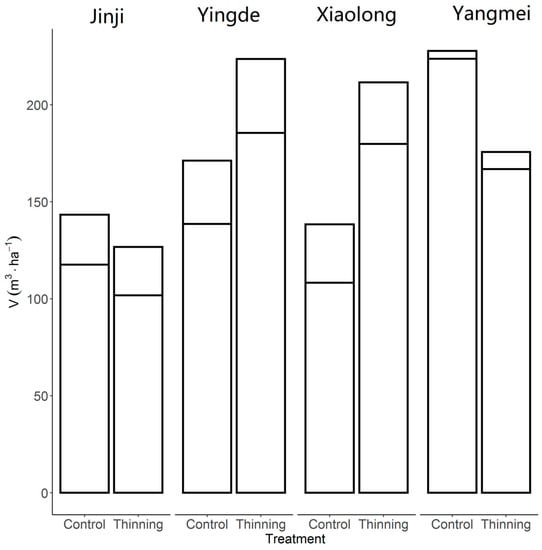
Figure 2.
The volume growth dynamics in the unmanaged plots (control) and thinning plots (thinning) in Yangmei, Jinji, Yingde, and Xiaolong forest farms. The cap of the bar is the mean forest volume increment since the treatments were applied.
3.2. Top Soil Acidity and Moisture
The soil pH values were significantly higher in 2021 than in 2020, whether in the thinning plots or in the unmanaged plots (Table 4). In the Jinji forest farm the pH values varied mostly (increased by 0.89 and 0.78 in control and thinning plots, respectively) among the four study sites. The results showed that the higher the density, the lower the soil pH (Figure 3). In the thinned plots or in 2020 (Prior), the SDI and pH were significantly related; however, they were insignificantly related in the control plots. The soil moisture decreased slightly with the increase of in density (Figure 3) in control plots or in 2020, however, in the thinned plots the situation was the opposite.

Table 4.
Mineral soil pH values (means ± standard errors) of different forest managements in different study sites, in 2020 and 2021. Different letters indicate significant differences between different years, and between different treatments in 2021 (p < 0.05). * n = 18, samples taken before thinning applied; ** n = 9, samples taken from control plots; *** n = 9, samples taken from thinning plots.
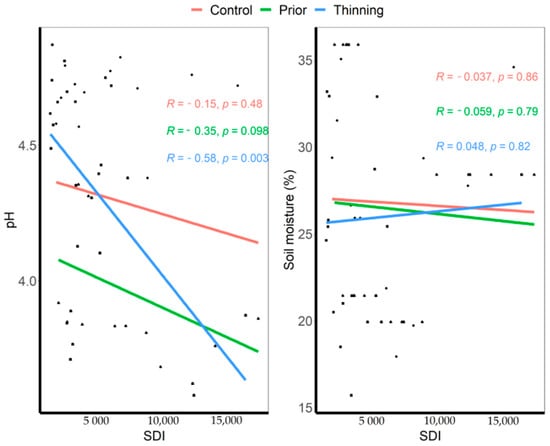
Figure 3.
The relationship between SDI and soil pH (left) and soil moisture (right) of different treatments.
3.3. C and N Contents in the Mineral Soil
The C content of the mineral soil was highest in Yangmei (20.67 g·kg−1) in 2020 before thinning was applied (Figure 4). The lowest C content was in Yingde for any treatments in 2020 and 2021 (2020: 16.22 g·kg−1; 2021: 15.82 g·kg−1 in the unmanaged plots; 17.02 g·kg−1 in the thinning plots). C contents in control plots increased compared to 2020, except for Yingde, where the C content decreased in the control plots in 2021. After thinning, the C contents increased in all plots, which increased most in Xiaolong (2.27 g·kg−1), then in Jinji (2.09 g·kg−1), Yingde (0.80 g·kg−1), and Yangmei (0.75 g·kg−1). The C contents changed insignificantly, whether in control or thinning plots.
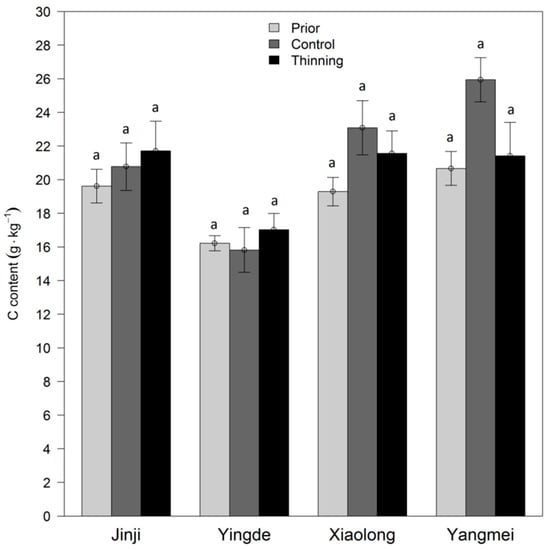
Figure 4.
Carbon contents in the mineral soil (0–10 cm) in 2020 (Prior),and unmanaged plots (control), and thinning plots (thinning) in 2021. Error bars are standard errors of estimates. Significant differences between treatments in the same study site are indicated by different letters (p < 0.05). The same letter “a” means there are no significant differences.
The N contents in the mineral soil decreased significantly in Yangmei (Figure 5) and increased in Xiaolong. In 2020, before thinning was applied, the highest N contents in the mineral soil were found in Yangmei (2.09 g·kg−1); however, in 2021, in control plots, the highest N contents were found in Xiaolong (2.06 g·kg−1). In Jinji, Yingde, and Xiaolong, the N content of thinning plots decreased less than that of control plots.
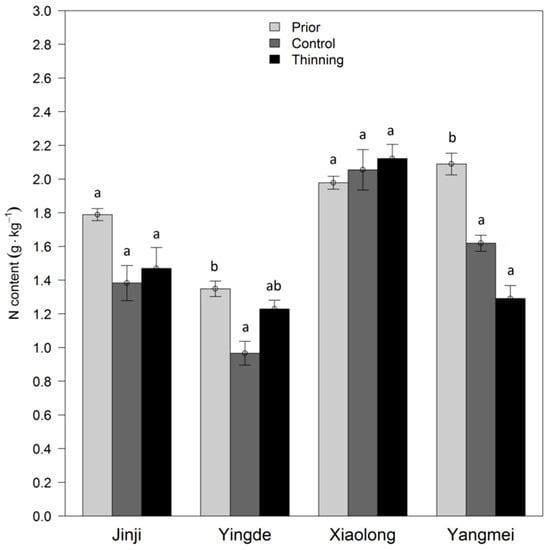
Figure 5.
Nitrogen contents in the mineral soil (0–10 cm) in 2020 (Prior), and in the unmanaged plots (control), and thinning plots (thinning) in 2021. Error bars are standard errors of estimates. Significant differences between treatments in the same study site are indicated by different letters (p < 0.05). The same letter in the same forest farm means no significant difference among prior, control and thinning. The different letters in the same forest farm mean significant differences among prior, control and thinning.
3.4. Understory Plant Diversity
The shrub and herb Shannon-Wiener indices were higher in the thinned plots than in the unthinned plots, except the plots in Jinji (Figure 6). Our study indicated that the shrub and herbaceous diversity increased with the increase in canopy openness (Figure 7). The thinned stands had a higher canopy openness than the control sites (Figure 8).
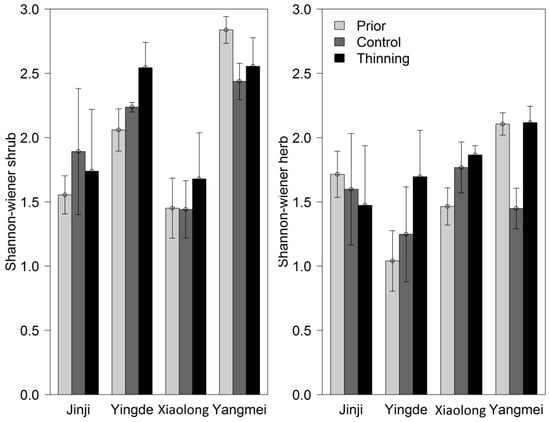
Figure 6.
The shrub Shannon-Wiener index and herb Shannon-Wiener index for different management types.
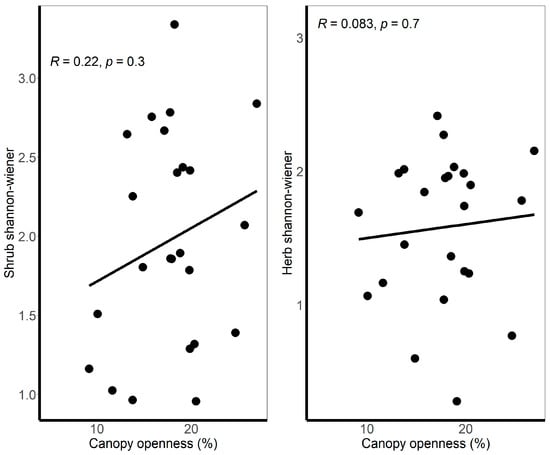
Figure 7.
The relationship between canopy openness and shrub diversity, and herb diversity.
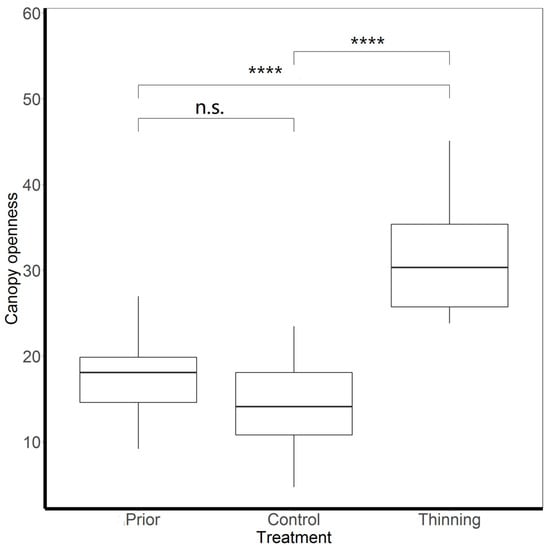
Figure 8.
Canopy openness for different management types: prior (before thinning, n = 24), Control (the control plots, n = 12), and thinning (thinning plots, n = 12). Box plots showing canopy openness for the differences before thinning (prior) and after management (control, thinning), and for the differences of different management (control, thinning). **** indicate significant differences (p < 0.01), Non-significant are marked by the abbreviation “n.s.”.
4. Discussion
We present results from a study investigating the short-term dynamics of tree growth and the soil nutrients in the even-aged Chinese fir plantations. We observed that thinning enhanced the efficiency of resources use of the trees, then promoted the growth of diameter and volume.
The difference between diameter growth (DQ) on control plots and thinned plots was greatest at SDI (Reineke’s density index) site (Figure 1, Table 2). The thinned stands at higher SDI responded better to thinning than stands at lower SDI. Other research shows similar tree growth responses to thinning [44,45]. In the control sites, the DQ was significantly related to soil C and soil N in a positive way, and to SDI in a negative way (Figure 9). However, in the thinned sites, the DQ was no longer related to soil C and N significantly. The pH values increased with the increase in canopy openness significantly. This could be increased levels of extractable inorganic N other than the total N, which improves forest growth [45,46]. In Jinji and Yingde, the soil C and N contents were higher than the control plots, in which the initial density was 4000 and 3000 trees·ha−1. There was no significant difference (p > 0.05) in soil nitrogen and carbon contents between thinning and control plots (Figure 4 and Figure 5). This result is consistent with the research of Xu et al. [33] and Cheng et al. [47], who carried out the short-term effect of thinning in 11- and 6-year-old Chinese fir plantations, respectively. In addition, Zhou et al. [48] and Gong et al. [49] found that thinning did not show a significant effect on mineral soil carbon stock in the short term, while it significantly increased carbon stocks in planted forests in the mid- and long term. Furthermore, other experimental evidence also shows that thinning in the fast-grown coniferous forests has no significant changes in nutrient stocking, for example, in Norway spruce [50] or in Scots pine [51,52].
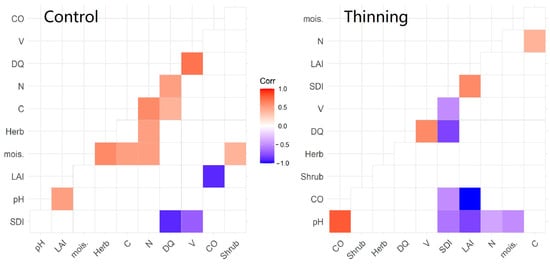
Figure 9.
Correlations of all measured elements of different treatments. The blank squares are no significant coefficient. “CO”: canopy openness; “V”: volume; “Herb”: Shannon-Wiener herb; “mois.”: soil moisture; “Shrub”: Shannon-Wiener shrub.
Thinning influenced the competition processes by creating space and heterogeneous environmental conditions, to promote the reserved tree growth and stand accumulation [53,54,55]. The density was related to diameter and volume negatively, however, in the thinning plots. However, in the thinning plots, the relationship between density and LAI was positive, which could explain why Jinji had the most growth rates. The reduced tree numbers with the relatively high LAI could be the other reason for the high increments of diameter and volume in the short term. However these temporary advantages in volume growth could be cancelled out later through the disadvantage of lower growth, which is caused by the lower number and advanced stem diameter of remaining trees [56].
Thinning could mitigate the drastic changes in soil pH caused by regional climate change. In this study, the pH values were significantly increased in 2021 in the control plots (Table 4). The result was contrary to drought may enhance protons release through enhancing rhizodeposition [57,58], and enhancing plant nutrient uptake under drought under the moderate drought [59]. This is due to the extreme drought in Guangdong in 2021; the mean precipitation was 1420.9 mm in 2021 which was 20.5% less than usual (Guangdong Provincial Water Resources Bulletin in 2021), and the mean temperature was 24.0 °C in 2021 which was the highest in history and 0.7 °C higher than usual (Guangzhou Climate Bulletin 2021). The result in the thinned sites could be explained by the negative relationship between soil moisture and pH. Thinning can improve soil moisture by increasing summer-time canopy moisture content for the remaining trees and increasing winter snow accumulation on the ground Sankey and Tatum [60], which indicated that thinning could mitigate the drastic changes in soil acidity. Therefore, we could say that forest thinning is a trade-off between loss of standing biomass and increasing stand stability as long as other indicators, such as soil condition, do not significantly change. The thinning effects on the resilience and elasticity of forests are due to the development of understory vegetation as well. Our study indicated that the shrub and herbaceous diversity increased with the canopy openness increasing (Figure 7). The shrub and herb Shannon-Wiener indices were higher in the thinned plots than in the unthinned plots, except the plots in Jinji (Figure 8). This is because even if the canopy openness was opened, the stand was still denser than other plots (2280 trees·ha−1 in thinning plots in Jinji, the densest stand among the four forest farms).
5. Conclusions
The results of this study indicated that the thinning of Chinese fir plantations improved the growth of reserved trees, mitigated the change in soil acidity caused by drought, and promoted the diversity of understory vegetation as well, in the short term. In our study, the promoting effect of thinning on growth is mainly caused by the change in the aboveground environment and soil nutrient availability and the effect of thinning varies with initial density and forest age. These findings suggested that thinning practice should be conducted at the early stage of middle-aged Chinese fir plantations, and the thinning intensity should be different according to the initial density.
Author Contributions
Conceptualization, S.C.; methodology, S.C. and N.L.; software, N.L.; validation, N.L.; investigation, N.L, N.D., D.L., M.F. and H.X.; data curation, N.L.; writing—original draft preparation, N.L. and N.D.; writing—review and editing, N.L.; supervision, S.C. All authors have read and agreed to the published version of the manuscript.
Funding
This research was funded by the Natural Science Foundation of Guangdong Basic and Applied Basic Research, grant number “2021A1515011092” and “Qingyuan Forestry Bureau”.
Data Availability Statement
Not applicable.
Acknowledgments
This work was supported by funding from the Natural Science Foundation of Guangdong Basic and Applied Basic Research Foundation, through the research projects 2021A1515011092, as well as the support from Qingyuan Forestry Bureau. The authors would like to thank all staff in the Yangmei, Jinji, Yingde, and Xiaolong forest farms. We also thank the editor and reviewers for their constructive comments on the manuscript.
Conflicts of Interest
The authors declare that they have no known competing financial interests or personal relationships that could have appeared to influence the work reported in this paper.
References
- Zhao, M.F.; Xiang, W.H.; Peng, C.H.; Tian, D.L. Simulating age-related changes in carbon storage and allocation in a Chinese fir plantation growing in southern China using the 3-PG model. For. Ecol. Manag. 2009, 257, 1520–1531. [Google Scholar] [CrossRef]
- NFGA. Forest Resources in China—The 9th National Forest Inventory; National Forestry and Grassland Administration: Bejing, China, 2019.
- FAO (Food and Agriculture Organization of the United Nations). Global Forest Resource Assessment 2020; Food and Agricultural Organization of the United Nations: Rome, Italy, 2020. [Google Scholar]
- Wu, Z.L. Chinese-Fir; China Forestry Publishing House: Beijing, China, 1984; 583p. (In Chinese) [Google Scholar]
- Ribe, R.G. In-stand scenic beauty of variable retention harvests and mature forests in the U.S. Pacific Northwest: The effects of basal area, density, retention pattern and down wood. J. Environ. Manag. 2009, 91, 245–260. [Google Scholar] [CrossRef] [PubMed]
- Lindenmayer, D.B.; Margules, C.R.; Botkin, D.B. Indicators of biodiversity for ecologically sustainable forest management. Conserv. Biol. 2000, 14, 941–950. [Google Scholar] [CrossRef]
- Neill, A.R.; Puettmann, K.J. Managing for adaptive capacity: Thinning improves food availability for wildlife and insect pollinators under climate change conditions. Can. J. For. Res. 2013, 43, 428–440. [Google Scholar] [CrossRef]
- McElhinny, C.; Gibbons, P.; Brack, C.; Bauhus, J. Forest and woodland stand structural complexity: Its definition and measurement. For. Ecol. Manag. 2005, 218, 1–24. [Google Scholar] [CrossRef]
- Dănescu, A.; Albrecht, A.T.; Bauhus, J. Structural diversity promotes productivity of mixed, uneven-aged forests in south western Germany. Oecologia 2016, 182, 319–333. [Google Scholar] [CrossRef] [PubMed]
- Juchheim, J.; Ammer, C.; Schall, P.; Seidel, D. Canopy space filling rather than conventional measures of structural heterogeneity explains productivity of beech stands. Forest Ecol. Manag. 2017, 395, 19–26. [Google Scholar] [CrossRef]
- Ehbrecht, M.; Schall, P.; Ammer, C.; Seidel, D. Quantifying stand structural complexity and its relationship with forest management, tree species diversity and microclimate. Agric. For. Meteorol. 2017, 242, 1–9. [Google Scholar] [CrossRef]
- Eichhorn, M.P.; Ryding, J.; Smith, M.J.; Gill, R.; Siriwardena, G.M.; Fuller, R.J. Effects of deer on woodland structure revealed through terrestrial laser scanning. J. Appl. Ecol. 2017, 54, 1615–1626. [Google Scholar] [CrossRef]
- MacArthur, R.H.; MacArthur, J.W. On bird species diversity. Ecology 1961, 42, 594–598. [Google Scholar] [CrossRef]
- Shi, S.Z.; Xiong, D.C.; Feng, J.X.; Xu, C.X.; Zhong, B.Y.; Deng, F.; Chen, Y.Y.; Chen, G.S.; Yang, Y.S. Ecophysiological effects of simulated nitrogen deposition on fine roots of Chinese fir (Cunninghamia lanceolata) seedlings. Acta Ecol. Sin. 2017, 37, 74–83. (In Chinese) [Google Scholar]
- Newton, P.F.; Weetman, G.F. Stand density management diagram for managed black spruce stands. For. Chron. 1994, 70, 65–74. [Google Scholar] [CrossRef]
- Haughian, S.R. Short-term effects of alternative thinning treatments on the richness, abundance and composition of epixylic bryophytes, lichens, and vascular plants in conifer plantations at microhabitat and stand scales. Forest Ecol. Manag. 2018, 415–416, 106–117. [Google Scholar] [CrossRef]
- Zenner, E.K. Differential growth response to increasing growing stock and structural complexity in even- and uneven-sized mixed Picea abies stands in southern Finland. Can. J. For. Res. 2016, 46, 1195–1204. [Google Scholar] [CrossRef]
- Qu, Y.C.; Wang, H.C.; Dean, T.J.; Zhang, J.G.; Zhang, X.Q. Growth dominance and growth efficiency in response to thinning treatments in Chinese fir plantations with long-term spacing trials. For. Ecol. Manag. 2022, 521, 120438. [Google Scholar] [CrossRef]
- Zhang, D.H.; Ye, Z.F.; Fan BYWei, T.L. Influence of thinning on soil fertility in artificial forests. Chin. J. Ecol. 2001, 12, 672–676. [Google Scholar]
- Xu, M.P.; Liu, H.Y.; Zhang, Q.; Zhang, Z.J.; Ren, C.J.; Feng, Y.Z.; Yang, G.H.; Han, X.H.; Zhang, W. Effect of forest thinning on soil organic carbon stocks from the perspective of carbon-degrading enzymes. Catena 2022, 218, 106560. [Google Scholar] [CrossRef]
- Baldwin, V.C.; Peterson, K.D. The effect of spacing and thinning on stand and tree characteristic of 38-year-old loblolly Pine. For. Ecol. Manag. 2000, 137, 91–102. [Google Scholar] [CrossRef]
- Skovsgaard, J.P. Analysing effects of thinning on stand volume growth in relation to site conditions: A case study for even-aged Sitka spruce (Piceasitchensis (Bong.) Carr.). Forestry 2009, 82, 87–104. [Google Scholar] [CrossRef]
- Castedo-Dorado, F.; Crecente-Campo, F.; Alvarez-Avarez, P.; Barrio-Anta, M. Development of a stand density management diagram for radiata pine stands including assessment of stand stability. Forestry 2009, 82, 1–16. [Google Scholar] [CrossRef]
- Schnell, S.; Kleinn, C.; Gonzalez, J.G.A. Stand density management diagrams for three exotic tree species in smallholder plantations in Vietnam. Small-Scale For. 2012, 11, 509–528. [Google Scholar] [CrossRef]
- Castaňo-Santamaría, J.; Barrio-Anta, M.; Alvarez-Alvarez, P. Regional-scale stand density management diagrams for Pyrenean oak (Quercus pyrenaica Willd.) stands in north-west Spain. iForest Biogeosci. For. 2013, 6, 113–122. [Google Scholar] [CrossRef]
- Tang, X.L.; Pérez-Cruzado c Vor, T.; Fehrmann, L.; Álvarez-González, G.; Kleinn, G. Development of stand density management diagrams for Chinese fir plantations. Forestry 2016, 89, 36–45. [Google Scholar] [CrossRef]
- Shen, Y.F.; Wang, N.; Cheng, R.M.; Xiao, W.F.; Yang, S.; Guo, Y. Short-term effects of low intensity thinning on the fine root dynamics of Pinus massoniana plantations in the Three Gorges Reservoir Area, China. Forests 2017, 8, 428. [Google Scholar] [CrossRef]
- Bodner, J. Effect of thinning and fertilization on wood properties and intra-ring characteristics in young Douglas-fir. Holzforsch. Und Holzverwert. 1984, 36, 5–11. [Google Scholar]
- Pommerening, A.; Murphy, S. A review of the history, definitions and methods of continuous cover forestry with special attention to afforestation and restocking. Forestry 2004, 77, 27–44. [Google Scholar] [CrossRef]
- Cheng, X.R.; Xing, W.L.; Yuan, H.J.; Yu, M.K. Long-term thinning does not significantly affect soil water-stable aggregates and diversity of bacteria and fungi in Chinese Fir (Cunninghamia lanceolata) plantations in eastern China. Forests 2018, 9, 687. [Google Scholar] [CrossRef]
- Li, Y.F.; He, J.A.; Lu, L.H.; Xu, J.M.; Wang, H.X.; Ye, S.M. The long-term effects of thinning and mixing on species and structural diversity of Chinese fir plantations. New For. 2021, 52, 285–302. [Google Scholar] [CrossRef]
- Willim, K.; Ammer, C.; Seidel, D.; Annighöfer, P.; Schmucker, J.; Schall, P.; Ehbrecht, M. Short-term dynamics of structural complexity in differently managed and unmanaged European beech forests. Trees For. People 2022, 8, 100231. [Google Scholar] [CrossRef]
- Xu, X.L.; Wang, X.J.; Hu, Y.; Wang, P.; Saeed, S.; Sun, Y.J. Short-term effects of thinning on the development and communities of understory vegetation of Chinese fir plantations in Southeast China. PeerJ 2020, 8, e8536. [Google Scholar] [CrossRef]
- Asaye, Z.; Zewdie, S. Fine root dynamics and soil carbon accretion under thinned and un-thinned Cupressus lusitanica stands in Southern Ethiopia. Plant Soil 2013, 366, 261–271. [Google Scholar] [CrossRef]
- Kim, C.; Son, Y.; Lee, W.K.; Jeong, J.; Noh, N.J. Influences of forest tending works on carbon distribution and cycling in a Pinus densiflora S. et Z. stand in Korea. For. Ecol. Manag. 2009, 257, 1420–1426. [Google Scholar] [CrossRef]
- Akburak, S.; Makineci, E. Thinning effects on soil and microbial respiration in a coppice-originated Carpinus betulus L. stand in Turkey. iForest 2016, 9, 783–790. [Google Scholar] [CrossRef]
- Ziche, D.; Grüneberg, E.; Hilbrig, L.; Höhle, J.; Kompa, T.; Liski, J.; Repo, A.; Wellbrock, N. Comparing soil inventory with modelling: Carbon balance in central European forest soils varies among forest types. Sci. Total Environ. 2019, 647, 1573–1585. [Google Scholar] [CrossRef] [PubMed]
- Leitgeb, E.; Ghosh, S.; Dobbs, M.; Englisch, M.; Michel, K. Distribution of nutrients and trace elements in forest soils of Singapore. Chemosphere 2019, 222, 62–70. [Google Scholar] [CrossRef] [PubMed]
- Table of Common Numbers for Forest Resources Investigation in Guangdong Province, Guangdong Provincial Forestry Bureau; P1; Guangdong Forestry Survey and Planning Institute: Guangzhou, China, 2009.
- Reineke, L.H. Perfecting a stand-density index for even-aged forest. J. Agric. Res. 1933, 46, 627–638. [Google Scholar]
- Frazer, G.W.; Canham, C.D.; Lertzman, K.P. Gap Light Analyzer (GLA): Imaging Software to Extract Canopy Structure and Gap Light Transmission Indices from True-Colour Fisheye Photographs, Users Manual and Program Documentation; Simon Fraser University, Burnaby, British Columbia, and the Institute of Ecosystem Studies: Millbrook, NY, USA, 1999. [Google Scholar]
- Arbeitskreis Standortskartierung in der Arbeitsgemeinschaft Forsteinrichtung. Forstliche Standortaufnahme; IHW Verlag: Munich, Germany, 1996. [Google Scholar]
- Meiwes, K.J.; Khanna, P.K.; Ulrich, B. Parameters for describing soil acidification and their relevance to stability of forest ecosystems. For. Ecol. Manag. 1986, 15, 161–179. [Google Scholar] [CrossRef]
- Brockley, R.P. Effects of post-thinning density and repeated fertilization on the growth and development of young lodgepole pine. Can. J. For. Res. 2005, 5, 1952–1964. [Google Scholar] [CrossRef]
- Chase, C.W.; Kimsey, M.J.; Shaw, T.M.; Coleman, M.D. The response of light, water, and nutrient availability to pre-commercial thinning in dry inland Douglas-fir forests. For. Ecol. Manag. 2016, 363, 98–109. [Google Scholar] [CrossRef]
- Forrester, D.I.; Collopy, J.J.; Beadle, C.L.; Warren, C.R.; Baker, T.G. Effect of thinning, pruning and nitrogen fertiliser application on transpiration, photosynthesis and water-use efficiency in a young Eucalyptus nitens plantation. For. Ecol. Manag. 2012, 266, 286–300. [Google Scholar] [CrossRef]
- Cheng, X.G.; Yu, M.K.; Li, Z.C. Short term effects of thinning on soil organic carbon fractions, soil properties, and forest floor in Cunninhamia lanceolata plantations. J. Soil Sci. Environ. Manag. 2018, 9, 21–29. [Google Scholar]
- Zhou, D.; Zhao, S.Q.; Liu, S.; Oeding, J. A meta-analysis on the impacts of partial cutting on forest structure and carbon storage. Biogeosciences 2013, 10, 3691–3703. [Google Scholar] [CrossRef]
- Gong, C.; Tan, Q.Y.; Liu, G.B.; Xu, M.X. Forest thinning increases soil carbon stocks in China. For. Ecol. Manag. 2021, 482, 118812. [Google Scholar] [CrossRef]
- Jonard, M.; Andre, F.; Ponette, Q. Tree species mediated effects on leaf litter dynamics in pure and mixed stands of oak and beech. Can. J. For. Res. 2008, 38, 528–538. [Google Scholar] [CrossRef]
- Novak, J.; Slodicak, M.; Dusek, D. Thinning effects on forest productivity and site characteristics in stands of Pinus sylvestris in the Czeck Republic. For. Syst. 2011, 20, 464–474. [Google Scholar]
- Bravo-Oviedo, A.; Ruiz-Peinado, R.; Modrego, P.; Modrego, P.; Alonso, R.; Montero, G. Forest thinning impact on carbon stock and soil condition in Southern European populations of P. sylvestris L. For. Ecol. Manag. 2015, 357, 259–267. [Google Scholar] [CrossRef]
- Sheng, W.T. Studies on density management and long-term productivity of Cunninghamia lanceolata forests. Sci. Silvae Sin. 2001, 37, 2–9. [Google Scholar]
- Lei, P.; Scherer-Lorenzen, M.; Bauhus, J. Belowground facilitation and competition in young tree species mixtures. For. Ecol. Manag. 2012, 265, 191–200. [Google Scholar] [CrossRef]
- Omari, K.; MacLean, D.A.; Lavigne, M.B.; Kershaw, J.A., Jr.; Adams, G.W. Effect of local stand structure on leaf area, growth, and growth efficiency following thinning of white spruce. For. Ecol. Manag. 2016, 368, 55–62. [Google Scholar] [CrossRef]
- Pretzsch, H. Density and growth of forest stands revisited. Effect of the temporal scale of observation, site quality, and thinning. For. Ecol. Manag. 2020, 460, 117879. [Google Scholar] [CrossRef]
- Kunhikrishnan, A.; Thangarajan, R.; Bolan, N.S.; Xu, Y.; Mandal, S.; Gleeson, D.B.; Seshadri, B.; Zaman, M.; Barton, L.; Tang, C.; et al. Functional relationships of soil acidification, liming, and greenhouse gas flux. Adv. Agron. 2016, 139, 1–71. [Google Scholar]
- Zhang, H.Z.; Shi, L.L.; Lu, H.B.; Shao, Y.H.; Liu, S.R.; Fu, S.L. Drought promotes soil phosphorus transformation and reduces phosphorus bioavailability in a temperate forest. Sci. Total Environ. 2020, 732, 139295. [Google Scholar] [CrossRef] [PubMed]
- Nilsson, L.O.; Wiklund, K. Nitrogen uptake in a Norway spruce stand following ammonium-sulfate application, fertigation, irrigation, drought, and nitrogen-free fertilization. Plant Soil 1994, 164, 221–229. [Google Scholar] [CrossRef]
- Sankey, T.; Tatum, J. Thinning increases forest resiliency during unprecedented drought. Sci. Rep. 2022, 12, 9041. [Google Scholar] [CrossRef] [PubMed]
Disclaimer/Publisher’s Note: The statements, opinions and data contained in all publications are solely those of the individual author(s) and contributor(s) and not of MDPI and/or the editor(s). MDPI and/or the editor(s) disclaim responsibility for any injury to people or property resulting from any ideas, methods, instructions or products referred to in the content. |
© 2022 by the authors. Licensee MDPI, Basel, Switzerland. This article is an open access article distributed under the terms and conditions of the Creative Commons Attribution (CC BY) license (https://creativecommons.org/licenses/by/4.0/).